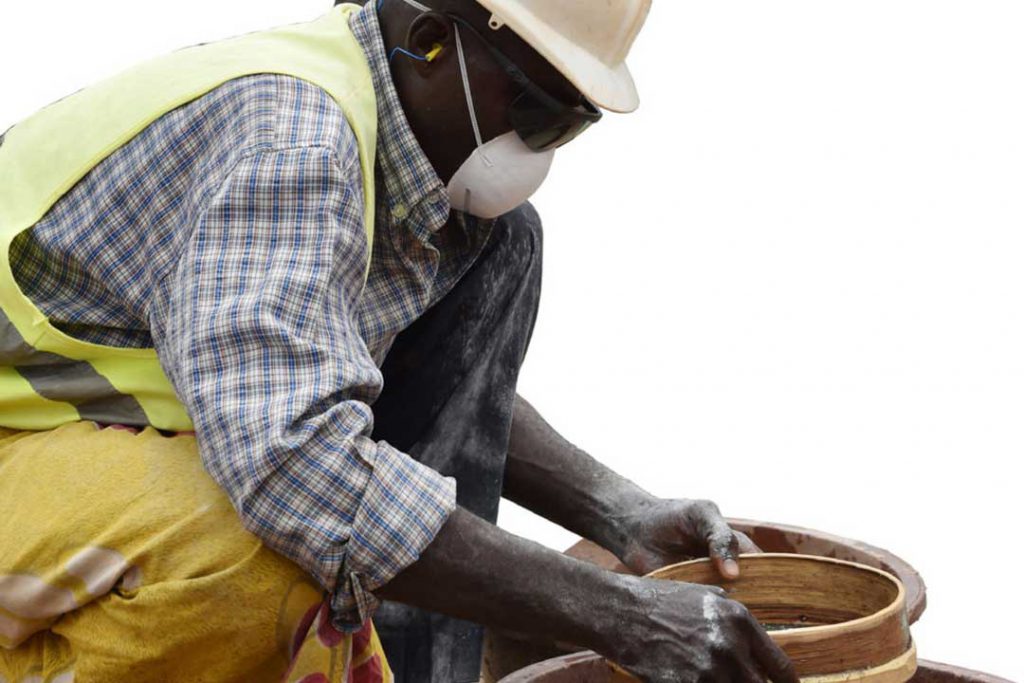
Picture taken on October 1, 2014 in Agbaou shows employees at work at the Agbaou gold mine, located approximately 200km northwest of the port city of Abidjan. Canada’s Endeavour Mining opened the Agbaou gold mine on January 2014 for a total cost of 180 millions of dollars, with annual production expected to reach three tonnes. With this fourth gold mine, Ivory coast’s Governement expect to reach the “national gold production from 13 to 16 tons per year.” AFP PHOTO / ISSOUF SANOGO / AFP PHOTO / ISSOUF SANOGO
There is an increasingly obvious parallel between the lack of shared value in any given mining project and heightened levels of social risk the project faces from local communities
The convergence of political, economic, social and environmental dynamics is accelerating in the age of the fourth industrial revolution. In this new world of “always on” technology, the mining sector, like many others, needs to adapt and align with the 2030 Agenda for Sustainable Development, as spearheaded by the UN, which set 17 global development targets known as Sustainable Development Goals (SDGs). As part of this, the mining sector needs to place the communities and environments in which it operates at the centre of its business.
At Mining Indaba 2017, Anglo American CEO Mark Cutifani stated in his keynote address: “we recognise that the only way we will be able to maximise business success in the short, medium and long term is if we help create thriving mining communities, continue to build on the positive impact of mining, reduce our environmental footprint and become more accountable partners, with our employees, communities, governments and NGOs.”
Agenda 2030 and the SDGs represent a global plan of action for social inclusion, environmental sustainability and economic development, but their attainment will heavily depend on high levels of cooperation and partnerships between all sectors and stakeholders. The various actors in the mining industry, like all others, will need to incorporate the SDGs, which put a great emphasis on the need for inclusive economic and social development, into their policies and practices.
This provides considerable scope for intersection with the concept of shared value in mining, a concept that highlights the need for governments to enjoy a fair income for the resources of which they are stewards. Governments around the world, as well as industry and civil society, have all endorsed this concept, but it is increasingly clear that its implementation has been inconsistent within and between countries. While there are examples of important success, there are far more examples of failure. Moreover, little research has been conducted to examine why shared-value projects succeed and why they fail.
Just as importantly, there is little research as to why some companies are leaders as regards engagement with the wider world and why many others do not effectively engage communities and governments to ensure that shared value and meaningful socio-economic development from mining become a reality. This, despite the fact that there is an increasingly obvious parallel between
the lack of shared value in any given project and the heightened levels of social risk the project faces from local communities. From this perspective, we can see that in the mining sector, social risk and shared value (or the implementation of the SDGs on social and economic development) are two sides of the same coin. As international financiers begin to insert this risk element into financing processes, it will become increasingly important to understand which factors support effective shared value and which factors work against it. Indeed, many observers of the resource-extractive industries now understand that the social risk caused by failure to meet social and economic development expectations is the riskiest area, after commodity price fluctuations.
Planning for economic and social development will increasingly need to be a collaborative effort between government, industry, labour, civil society and local communities. But the research base to understand how to make this effort successful is currently ad hoc and inconsistent. Much more effort and consistency in this regard will be needed before all stakeholders feel that they are able to achieve effective results.
Globally, the mining industry continues to grapple with how it should best contribute to sustainable development. Ensuring shared value and sustainable socio-economic development is, in many cases, bedevilled by fraught relations between mining companies on the one hand and host country governments and mine-affected communities on the other.
The cost of ignoring a shared-value approach has become evident, but equally it remains a challenge to successfully demonstrate its benefits. There is an increasingly urgent need to better interrogate available data to understand the highly complex set of factors that determine the distribution of costs and benefits arising from mining.
To this end, and to enhance mining’s contribution to achieving SDGs, it will be necessary to address a series of issues that continue to give rise to social risk –some of which prevent outcomes based on the shared-value vision. These are too numerous to list in detail here, but they include matters such as: the impact of advances in mining technology; greater mechanisation; the changing face of migration; the need for legacy planning in mature mining jurisdictions for alternative or substitute economic activities; regional cooperation by industry; the drive for improved health and safety; pollution; climate change; and reducing the environmental impact of operations, among others.
With hindsight, conventional computing solutions based on rules and logic that follow rigid decision-free approaches have proven to be inadequate. This approach has not yielded much-needed insights into the social dynamics at play in the mining industry. In an era where there is a pressing need for more complex, evidence-based decisions, more innovative and effective approaches to policy orientated research in the mining industry are urgently needed.
Advancements in big-data processing power and machine-learning technologies offer an opportunity to accelerate and deepen our understanding of complex, interconnected issues and enable problem solving on a scale previously inconceivable.
As the initiator and driver of the Socio-Economic Technology Initiative (SETI) project, Mining Dialogues 360° (MD360°) contends that mining areas can be enriched and mining’s socio-economic impact and contribution to sustainable development significantly improved by the appropriate use of innovative technology in data gathering, information management and analysis, and development-planning frameworks. This approach should also result in a more equitable distribution of the shared value arising from extractive industries.
The SETI project has recently successfully completed a proof-of-concept to trial the aggregation of existing knowledge and data from multiple sources and in multiple formats. By applying innovative and advanced computing technologies that emulate human analytical processes at speed and scale, the aim is to create a globally applicable resource or instrument that will enable all stakeholders in the industry to provide a unique analysis of socio-economic information pertaining to mining and its positive and negative impacts. Critically, it will allow for direct input from and feedback to communities affected by mining, thus ensuring their participation in making decisions.
Inclusivity, and the participation level of all stakeholders, can be enhanced by improving their access to a larger and more complex body of information, as well as by providing intuitive instruments that improve users’ ability to obtain key insights, and gain a deeper understanding, of the issues facing those affected by mineral-resource extraction. This should permit more collaborative approaches to planning and, therefore, more effective decision-making by all parties, which in turn should result in better socio-economic outcomes.
The adoption of this wide-ranging and inclusive approach should also result in greater transparency, objective monitoring and evaluation, and effective accountability. The UN World Data Forum has adopted the motto: “Leave no one behind”. We believe this is possible if mining’s contribution to achieving the SDGs is enhanced so as to ensure that shared value becomes more of a reality.
MD360° and its partners in the SETI project are now focusing on research, as a phase one pilot project, to develop and “incubate” instruments or technology tools that can enhance the efficacy of local development planning frameworks. As a neutral, objective dialogue and research platform, MD360° is using its credibility with stakeholders, especially with communities, to drive innovative collaboration.
The aim is not only to understand historical and present-day contexts, but, critically, to create scenario-planning tools that will allow for improved engagement, thus putting communities and their environments at the centre of development.
The mining industry has the potential to positively contribute, but also negatively, to all 17 SDGs. The diversity, scope and nature of the mining industry highlight some SDGs where mining can have a particularly significant impact. Most importantly, the mining industry needs to ramp up its engagement, partnership and dialogue with other sectors and stakeholders to address these challenges.
Tracey Cooper is a founding member and executive director of Mining dialogues 360. She leads a collective of experts who produce empirical, evidence-based research that provides the basis for frank and robust dialogue on the socio-economic issues arising from the extractive industry. She has consulted in communications and outreach, working with organisations such as the United Nations Development Programme (UNDP), United Nations Environment Programme (UNEP), Gates Foundation and the International Renewable Energy Agency (IRENA) , among others.













